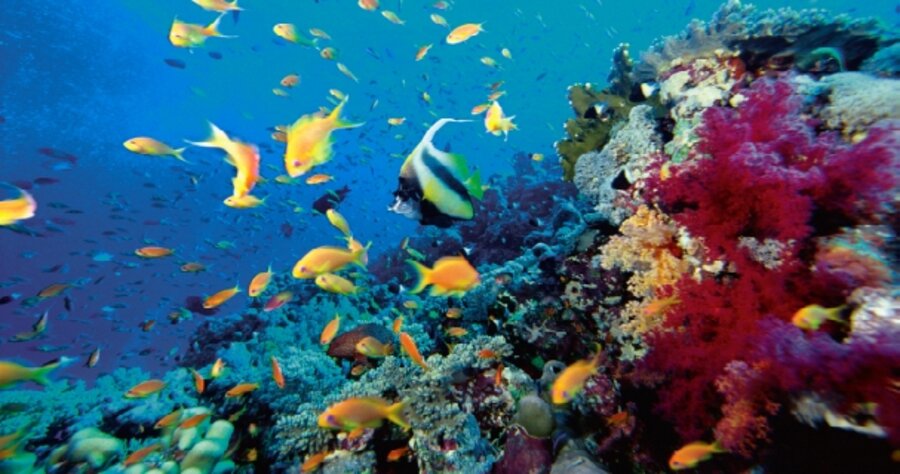Stepping back from the acidic abyss
Loading...
If you have to issue a declaration of some sort, Kona, on the big island of Hawaii, isn't a shabby place to do it. Especially if the topic involves coral reefs and ocean acidification.
The venue: The 20th meeting of the US Coral Reef Task Force, set up in 1988 to coordinate the nation's efforts to preserve these important marine habitats. Today, a group of prominent marine scientists presented the task force with its "Honolulu Declaration on Ocean Acidification and Reef Management. " The four-page document (five if you count references) puts its main focus on what conservation managers can do now to try to ensure some level of resilience in their reef networks as oceans acidify. In many ways, it's the latter that distinguishes this from other declarations of angst over acidification.
That's not to pooh-pooh the phenomenon; the oceans are growing acidic. It's the result of the ocean's uptake of the some of the carbon dioxide human industrial activities are pumping in to the air. No fuss, no muss, no models (unless you really want to use them), just fundamental chemistry. As one engineering professor told to me back in 2001 when we were chatting about carbon sequestration technologies, even if he didn't sign off on the idea of human-triggered global warming (which he did), the idea that we're acidifying the oceans would be enough to keep him awake at night. Scientists have been studying this issue at least since the early 1980s. By the late 1990s, they had come up with measurements suggesting that the ocean's pH -- the standard unit for measuring how acidic or basic a liquid is -- had slipped 0.1 units lower than it was before the Industrial Revolution. This led to projections three years ago that the Southern Ocean would start to show strong signs of acidification -- essentially through a loss in the ability of organisms such as clams and deep-sea corals to make shells and skeletons. This past June, however, researchers from Canada, the US, and Mexico reported the results from study of water samples they pulled up along the continental shelf off Canada, the US West Coast, and Mexico's Baja California. They found water from the deep ocean moving onto the continental shelf -- and displaying the tell-tale signs of acidification. Different ocean, and faster than projected three years ago. Scientists often express their concerns about this in terms of near-surface water growing more acidic. So where did this deep more-acidic water come from? The deep-ocean conveyor, according to Richard Feely, a scientist at the National Oceanic and Atmospheric Administration's Pacific Marine Environmental Laboratory. Based on their measurements, the team estimates that the water they were sampling last saw the surface 50 years ago in the western North Pacific off Japan. Essentially, they found that the ocean is kicking back to the surface waters that grew more acidic before anyone started to give atmospheric CO2 and ocean acidification much thought.
And the concern: corals, certain forms of plankton, and shellfish will have an increasingly hard time surviving, because acidic waters will have removed the carbonate ions that might otherwise have been available for shell-building. Until now, this idea has largely been tested in the lab, with results that don't bode well for such marine creatures. Two papers were published in July that show the effect of acidification on reefs in the Galapagos and ecosystems around hydrothermal vents in the Mediterranean. In these cases, the sources of acidifying action on seawater were natural. But the results mirrored those in the lab. In the Med, shells of creatures such as whelk and abalone started to dissolve when CO2 concentrations rose as vents erupted. Interestingly, the difference in pH between between quiet times and eruptions is about the same the ocean in general is expected to reach by 2100, according to Jason Hall-Spencer, the lead author of the study. Some of the striken creatures are similar to those that earn the fishing industry big bucks off North America's west coast. In the Galapagos, acidification increased the reefs' vulnerability to erosion.
Which brings us (finally!) back to today's declaration. The document has its plea to reduce CO2 emissions as "the most logical and critical action" to head off the effects of additional acidification. But, says Rod Salm, the group of scientists didn't want to stop there. Dr. Salm is a reef ecologist who heads the Nature Conservancy's tropical-marine conservation program and is one of the declaration's signers. The politics of mitigation is too messy and time consuming to wait, especially when resource managers can take actions now that could help.
Note: Eoin O’Carroll is on vacation. He will return Sept. 2





